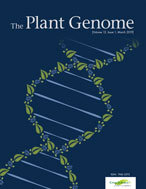Ver ítem
- xmlui.general.dspace_homeCentros Regionales y EEAsCentro Regional Buenos Aires SurEEA BalcarceArtículos científicosxmlui.ArtifactBrowser.ItemViewer.trail
- Inicio
- Centros Regionales y EEAs
- Centro Regional Buenos Aires Sur
- EEA Balcarce
- Artículos científicos
- Ver ítem
Gene content and distribution in the nuclear genome of Fragaria vesca
Resumen
Thirty fosmids were randomly selected from a library of Fragaria vesca subsp. americana (cv. Pawtuckaway) DNA. These fosmid clones were individually sheared, and ∼4- to 5-kb fragments were subcloned. Subclones on a single 384-well plate were sequenced bidirectionally for each fosmid. Assembly of these data yielded 12 fosmid inserts completely sequenced, 14 inserts as 2 to 3 contiguous sequences (contigs), and 4 inserts with 5 to 9 contigs. In most cases,
[ver mas...]
Thirty fosmids were randomly selected from a library of Fragaria vesca subsp. americana (cv. Pawtuckaway) DNA. These fosmid clones were individually sheared, and ∼4- to 5-kb fragments were subcloned. Subclones on a single 384-well plate were sequenced bidirectionally for each fosmid. Assembly of these data yielded 12 fosmid inserts completely sequenced, 14 inserts as 2 to 3 contiguous sequences (contigs), and 4 inserts with 5 to 9 contigs. In most cases, a single unambiguous contig order and orientation was determined, so no further finishing was required to identify genes and their relative arrangement. One hundred fifty-eight genes were identified in the ∼1.0 Mb of nuclear genomic DNA that was assembled. Because these fosmids were randomly chosen, this allowed prediction of the genetic content of the entire ∼200 Mb F. vesca genome as about 30,500 protein-encoding genes, plus >4700 truncated gene fragments. The genes are mostly arranged in gene-rich regions, to a variable degree intermixed with transposable elements (TEs). The most abundant TEs in F. vesca were found to be long terminal repeat (LTR) retrotransposons, and these comprised about 13% of the DNA analyzed. Over 30 new repeat families were discovered, mostly TEs, and the total TE content of F. vesca is predicted to be at least 16%.
[Cerrar]

Autor
Pontaroli, Ana Clara;
Rogers, Rebekah L.;
Qian, Zhang;
Shields, Melanie E.;
Davis, Thomas M.;
Folta, Kevin M.;
SanMiguel, Phillip;
Bennetzen, Jeffrey L.;
Fuente
Plant Genome 2 (1) : 93-101 (2009)
Fecha
2009-03
Editorial
Crop Science Society of America
ISSN
1940-3372
Formato
pdf
Tipo de documento
artículo
Palabras Claves
Derechos de acceso
Abierto
 Excepto donde se diga explicitamente, este item se publica bajo la siguiente descripción: Creative Commons Attribution-NonCommercial-ShareAlike 2.5 Unported (CC BY-NC-SA 2.5)
Excepto donde se diga explicitamente, este item se publica bajo la siguiente descripción: Creative Commons Attribution-NonCommercial-ShareAlike 2.5 Unported (CC BY-NC-SA 2.5)


